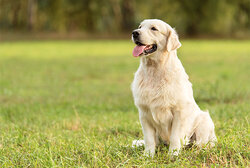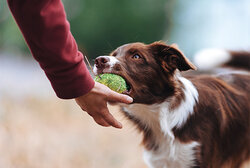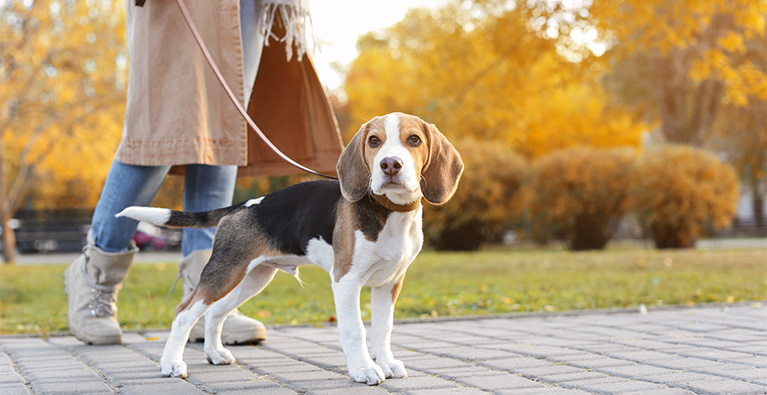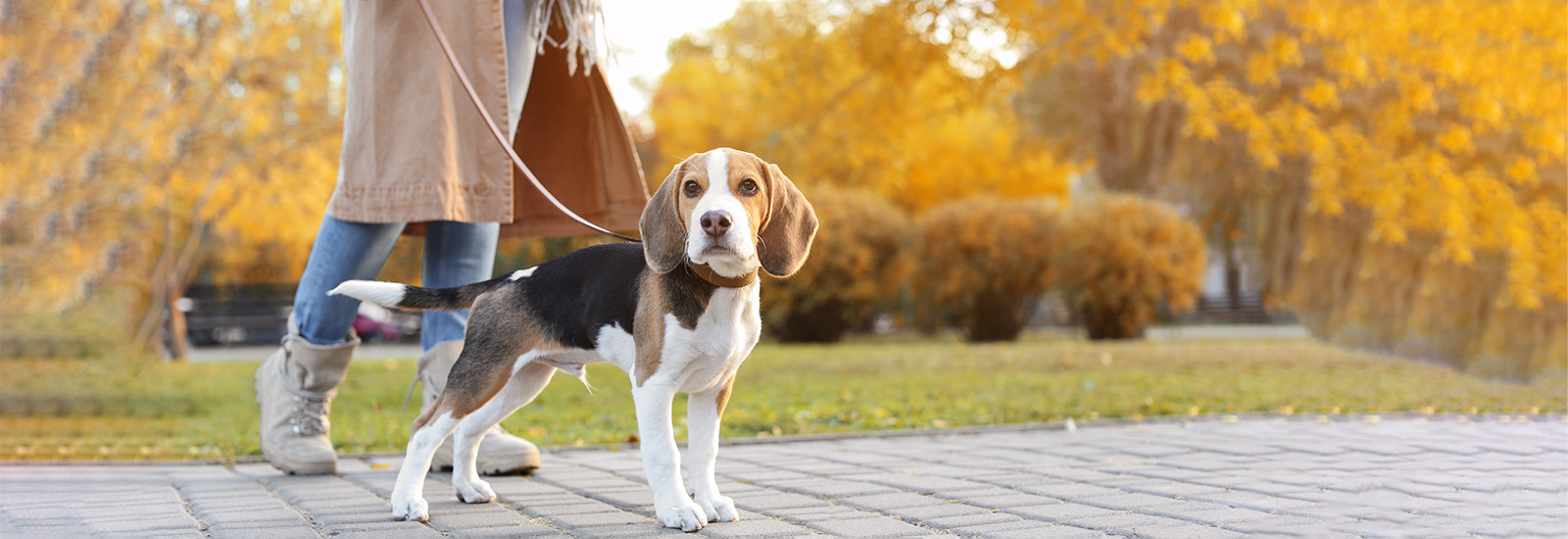Lead training
It is great to have a dog that does not pull on its lead all the time. In reality, however, things are usually quite different. We will show you how you can train your dog step by step to walk properly on a lead.
When a dog keeps pulling on its lead
When people take their dogs for a walk, they sometimes wonder who is actually walking whom. It is fine to show consideration for your pet and to let it sniff here and there undisturbed and allow it to follow a scent for a few metres. However, if this is not on the planned route, then your pet must also learn to accept that you want to go in a different direction. It is also a nuisance if your dog always thinks it has to set the pace and keeps pulling on the lead. This is actually quite understandable, because it is in a dog’s nature to often walk faster than we do.
To solve this problem, some dog owners decide to use a retractable lead. This is not suitable for teaching your dog the commands “Heel!” and “Lead!”, but it is an acceptable intermediate solution. This flexible type of lead balances out the short pauses for sniffing and the subsequent trotting back to you, making it much easier for you to keep up your walking pace than with a short, fixed-length lead. This does, however, only work around a possible problem. If you really want to resolve the issue properly, you will have to resort to other measures, because a dog can also pull on a retractable lead.
The difference between “Lead!” and “Heel!”
Many dog owners do not realise that there is a difference between the commands “Lead!” and “Heel!”. “Lead!” requires the dog to walk beside you in such a way that its lead is generally slack and only very slightly taut every now and then. The traditional “Heel!” command, on the other hand, is more at home at a dog training ground. This command requires the dog to walk attentively right beside you, no matter whether it is on or off the lead. If, however, you do not require this, then it does not matter which command you choose. “Heel!” or any other command will work just as well, as long as the dog associates it with walking on a loose (slack) lead.
When a puppy keeps pulling on its lead
With a puppy, it is important to be lenient. It first has to get used to its collar, harness and lead. This can take some time, especially when you consider that puppies only have a very short span of attention. First of all, it is only important that the dog does not associate the walking equipment with any unpleasant feelings. Therefore, scolding, using force and yanking on the lead are completely taboo! A negative association can result in long-lasting problems. Instead, the collar, harness and lead should always have positive associations. This means praising the puppy when it is wearing its collar and is at least walking along with you on the lead to some extent.
Creating positive experiences with the lead
Whether you have a puppy or an adult dog – if your pet has had negative experiences with its lead, this will make it more difficult to get it to walk on a loose lead. The trick is therefore to make sure that it associates positive situations with the lead. To do this, avoid only using the lead when your dog has just done something wrong, and telling it off in a situation connected with the lead! Instead, you should also put your pet on the lead while you are giving it a cuddle, playing with it or walking up to the treat box.
How can I teach my dog to walk on a lead?
If your dog is a typical lead puller, follow these steps:
- Have treats ready
When learning typical basic commands such as “Sit!” and “Down!”, it is common for dog owners to use treats. But when it comes to learning how to walk on a loose lead, this is rarely the case. This is surprising, because treats are just as effective here as they are with any other command! So make sure that you have a bag of tasty treats with you. On your walk, reward your dog every time it looks back at you or does not tug on the lead. It may at first come as a surprise to your pet that you are suddenly giving it treats during the walk. At first it will probably not be able to comprehend why this is happening. After all, walks on a lead are often not exactly relaxed, and involve your dog being told off and not receiving any treats.
- Choose the right time and place
If you want to train your dog to walk on a lead, it is best to choose somewhere with very few distractions. This should definitely not be a busy dog park or a place that has interesting smells for the dog. Although it may seem a little unusual, you can start by practising at home, for example, in the living room. Or in the garden, which will normally be free of any surprises or distractions. Alternatively, choose a path or a field that is not littered with stimuli for your dog.
- Your attitude is everything
If you no longer want to be the one being pulled along behind the lead, then you need to modify your attitude and behaviour. Do not let your dog take over, and make sure that you are the one who is in charge. This will not be possible if you spend most of your time looking at your mobile phone or following behind your pet apathetically. Make it crystal clear to both your dog and yourself that you are the boss and that you call the shots. You have to take this to heart and really want it, because only then will you communicate it in a way that the dog will notice.
- Come to a halt & make sudden changes of direction
If a dog is used to getting its own way by tugging on the lead and going wherever it wants to go, it will be rather surprised if there are suddenly two new variations. One is to stubbornly stay in one place until the lead is slack again. The second is to make sudden changes of direction every time the dog pulls on the lead.
- Always remain firm
Now it is time to show your staying power! As soon as you succumb to letting your dog get away with tugging on the lead again and you start running after it, it signals to your pet that this does still work after all and that it simply has to keep it up for long enough. If you want to change something, you have to take charge. This should not only be done with stops and changes of direction, but also with praise at the right moments. One such moment is when the dog looks up at you. This is never, or at least rarely the case when it is tugging at the lead. It therefore deserves praise and treats as soon as it looks back at its owner for a moment.
Also, you should not take it for granted when your dog occasionally walks on a loose lead. Let your dog know that it is doing something well. Just like with other commands and tricks, the dog has to learn by means of numerous repetitions exactly what behaviour is required and will result in a reward. Even though it may not seem special to others, praise your dog for simply walking normally on a loose lead, because after all, this is what every dog owner wants.
- Increase the level of difficulty
The fewer distractions there are around, the easier it should be for your dog to glance at you occasionally. It has to learn that this behaviour is desired and that it will be rewarded. Ideally, your pet will hardly ever pull on its lead, but many dog owners are delighted if this works on command for at least a short period of time. You should therefore associate exemplary walking on the lead with a command such as “Lead!” or “Heel!”. But do not ask too much of your dog at first: when another dog comes up to it, it is almost impossible to hold back your four-legged friend. It is best not to try this out at all at the beginning, but instead to concentrate on easier situations. Any positive experiences you have here can already be seen as a sign of success.
Video about lead training
Would you like to see lead training on video? Animal trainer Fränzi Lüttich demonstrates how it works with Weimaraner Sky and dachshund Polly:
You may also like this

Teaching your dog the commando "Down"
“Down!” is one of the most important commands a dog should master

Teaching your dog to sit
How to teach your dog to sit

Teaching your dog the command "Stay"
How to practice the command "Stay" with your dog

Teaching a dog the command “Drop it”
The command "Drop it" is very important





